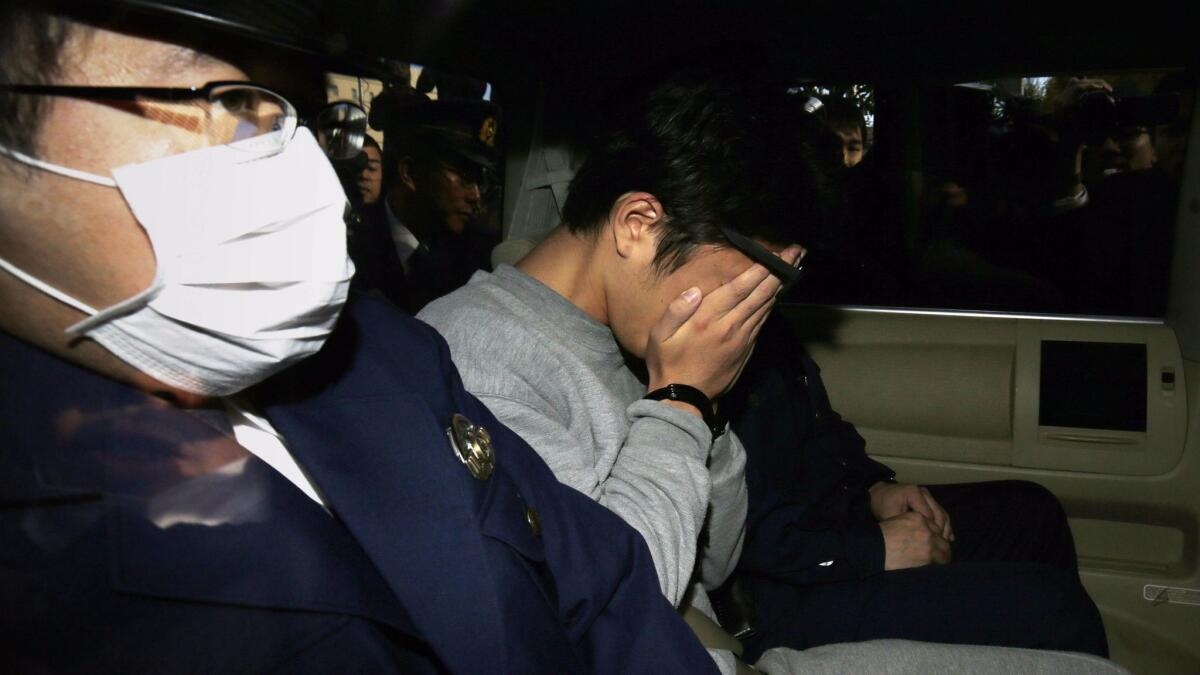As Japan’s serial killing case unfolds, people ask: Did killer find victims through Twitter?

Reporting from TOKYO — After Aiko Tamura, a 23-year-old Tokyo resident, posted on Twitter her desire to commit suicide, her brother frantically began looking for clues to her whereabouts after she went missing Oct. 21.
His efforts triggered a police raid that uncovered a horrifying scene in a studio apartment in central Japan: nine severed heads, along with about 240 human bones packed in boxes filled with cat litter in an apparent attempt to conceal the stench.
For the record:
4:15 p.m. Nov. 10, 2017An earlier version of this article said Takahiro Shiraishi was arrested Oct. 30. He was arrested Oct. 31.
As authorities continue their investigation — the remains of Tamura and eight other victims have been identified — many in Japan are asking how social media was used to reach the victims and whether it can unwittingly bolster destructive or suicidal thoughts.
On Oct. 31, Japanese police arrested 27-year-old Takahiro Shiraishi of Zama City, in Kanagawa Prefecture near Tokyo. He faces one charge of disposing of dead bodies, but more charges are expected.
“This is a case where cries for help were exploited, and [victims] were manipulatively drawn out,” Japan’s chief Cabinet secretary, Yoshihide Suga, said at a news conference Friday. “The tactics used were extremely vile.”
Suga said a multi-agency committee to propose prevention plans to avoid a repeat of the Zama case has been launched. The group will review how to deal with suicide postings on the internet and how to better support troubled youths. It aims to wrap up its findings by the end of the year.
Placing regulations on Twitter is not absolute but is “likely to be considered,” Suga said. Twitter did not return requests for comment Friday on his remarks.
Along with Tamura, the remains of seven other women were discovered, authorities said. One victim was male. The oldest was 26, the youngest 15. Police estimated that two of the victims had been dismembered only a week or two before Shiraishi’s arrest. The rest had been dead for weeks or months.
The case continues to unfold as San Francisco-based Twitter announced new global guidelines concerning posts on self-destructive behavior. On Nov. 3, the company unveiled rules saying Twitter users “may not promote or encourage suicide or self-harm.”
“We did not rewrite the section on suicide and self harm because of this case, but we would like to avoid these types of cases from happening,” Kaori Saito, a Twitter spokeswoman in Japan, said two days before Suga’s comments at Friday’s news conference. “We are adding more wording to the rules on [suicidal posts] and clarifying what’s OK and what’s not OK” on Twitter.
Japanese media outlets, citing police sources, say Shiraishi approached most victims using Twitter. Shiraishi, who authorities say referred to himself as a suicide expert on hanging, told his victims he would help them with their suicides, even die with them, reports said.
One Twitter account linked to him, @hangingpro, carried the message: “I would like to help those who are truly suffering. Feel free to DM me.”
According to media reports, Shiraishi used to work in the red light district of Tokyo as a scout, someone charged with finding women to work as prostitutes. He moved to the Zama apartment Aug. 22.
Within a week or so of moving in, Shiraishi killed his first victim, police estimate. Authorities say that he attacked his victims after offering them alcohol or tranquilizers, adding that many of the remains were thrown out with his trash. Neighbors have noticed strong odors coming from the garbage area and Shiraishi’s room for two months, police said.
Plastic bands, ropes, a saw, a hatchet and kitchen knives have been recovered by investigators from Shiraishi’s apartment. Multiple bank cards, medical cards, train cards and bags of victims’ belongings and remains also have been recovered from the scene, according to police records.
Investigators identified the remains found with Tamura through DNA analysis. Local media reports say three of the female victims were high school students and one attended college. The one man who was killed was reportedly the boyfriend of a 21-year-old.
Critics have pointed out how Twitter — which is used more than Facebook or Instagram by Japanese teens and 20-somethings, according to Japanese government data — could be misused in a country with high suicide rates. Twitter has 45 million monthly users in Japan, one of the countries with the largest number of Twitter users outside the U.S.
The majority of Twitter users in Japan are young people, and the app is popular because it allows for anonymity, a safe place in a country where speaking your thoughts openly can still be a cultural taboo, said Masakatu Morii, professor of information and communication technology at Kobe University.
Social media sites have been a convenient outlet for young people contemplating suicide to reach out to others, said Yasuyuki Deguchi, professor of criminal psychology at Tokyo Future University. In most cases, those feeling suicidal probably just wanted to talk to someone and not actually die, he said.
To avoid further cases like the Zama one, representatives at suicide prevention organizations say steps should be taken to stop predators from preying on troubled youths.
It may be prudent to ban those under 18 from using social media like Twitter in the same way they aren’t legally allowed to smoke or drink alcohol, said Masashi Yasukawa, president of nonprofit National Web Counseling Council, which trains youth counselors. Middle school and high school students don’t have enough life experience and can be too trusting of strangers on social media, Yasukawa said.
Japanese youths are comfortable communicating through texts, said Jiro Ito, representative of Tokyo-based suicide prevention nonprofit OVA. Telephone hotlines have long been available, but given the comfort level young people have with texting and Twitter, perhaps text-based counseling and intervention programs should be made available, he said.
As for the Twitter account @hangingpro, it has been suspended.
Nagano is a special correspondent.
More to Read
Sign up for Essential California
The most important California stories and recommendations in your inbox every morning.
You may occasionally receive promotional content from the Los Angeles Times.










